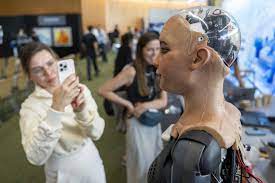In an effort to start a conversation on the future of artificial intelligence, a United Nations technology agency gathered a group of robots that physically resembled people at a news conference on Friday. They allowed reporters to ask them questions.
The International Telecommunication Union of the United Nations touted the event as the world’s first press conference involving humanoid social robots. The nine robots sat and posed erect at a podium in a Geneva conference center, together with some of the people who worked on their creation.
Among them are Desdemona, a rock star robot, Grace, a robot characterized as a health care provider, and Sophia, the first robot innovation ambassador for the United Nations Development Program, or UNDP. Two of them, Geminoid and Nadine, looked like their creators.
The purpose of the event at the AI for Good Global Summit, according to the organizers, was to demonstrate the potential applications of robotics for the United Nations’ sustainable development goals as well as their potential drawbacks. The robots’ companions or designers gave introductions at the media event, and reporters then asked the robots a series of questions.
While the robots made assertive claims, such as that they might be more effective leaders than humans but wouldn’t steal anyone’s job or start a revolution, the event organizers made no mention of how much of the robots’ responses were planned or programmed by humans.
The summit’s goal was to demonstrate “human-machine collaboration,” and some of the robots were able to respond in a predetermined way, per their documentation. According to the company’s website, the UNDP’s Sophia occasionally uses written responses created by a team of writers at Hanson Robotics.
When speaking to the robots, reporters were instructed to speak slowly and carefully. They were also told that any response delays would be caused by the internet connection, not the robots themselves. That didn’t stop awkward silences, audio issues, or occasionally stilted or inconsistent responses.
For more than a decade, well-known tech products like Apple’s Siri have used speech recognition technology to react to comparatively straightforward human enquiries. However, the launch of ChatGPT, a chatbot that has a deep grasp of the semantics and syntax of human language, last year has sparked a global discussion concerning the quick development of AI systems.

















